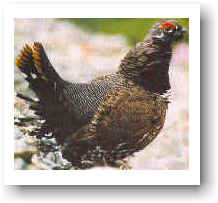
Spruce Grouse
Falcipennis Candensis
Status
Introduced to Newfoundland.
Habitat
Spruce Grouse prefer coniferous and mixed wood forests, forest edges and openings, as well as older burnt lands and blueberry barrens.
Range
Spruce Grouse occur throughout Canada, except Prince Edward Island and Anticosti Island. They are found North to the treeline.
Food
Diet varies by season. Primary source is coniferous needles and buds, especially in winter. During summer, they prefer ground plants, berries and arthropods.
Predators/Threats
The principle predators of the Spruce Grouse are the lynx, fox and some large birds of prey, particularly the goshawk. Humans are also a major threat to the Spruce Grouse as they are a popular game bird.
Lifespan
Longest known record is 13 years but average lifespan of the Spruce Grouse is considerably less.
Appearance
Spruce Grouse are crow-sized forest birds. Males are gray-brown above with black throat and breast; variable white tipping along sides, sometimes forming partial or complete breast band. Red eye combs are conspicuous during courtship and display; short, black tail, usually with chestnut tip. Females vary from reddish to grayish-brown; heavily barred; spotted white below on blackish background; tail dark with brown or buff tip; lacks red eye combs.
Breeding Biology
Nests are depressions in the ground lined with grasses and leaves. Female lays between 4-7 buff eggs with brown markings. Incubation by the female begins when the clutch is complete and takes approximately 24 days.
Average Weight/Measurements
Total length is 38-43 cm; average weight is 456 g (female) and 492 g (male).
Notes:
- Spruce Grouse are sometimes referred to as “Fool Hens”, often preferring to remain motionless and rely on their camouflage to avoid predators rather than fleeing.
